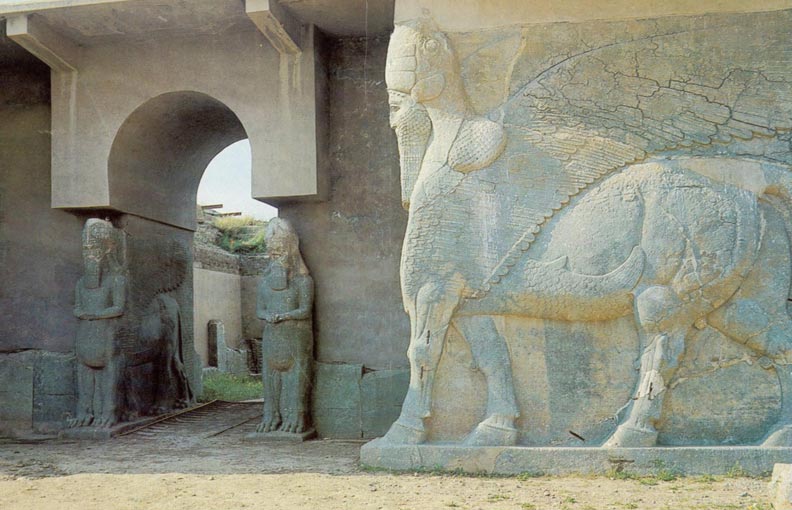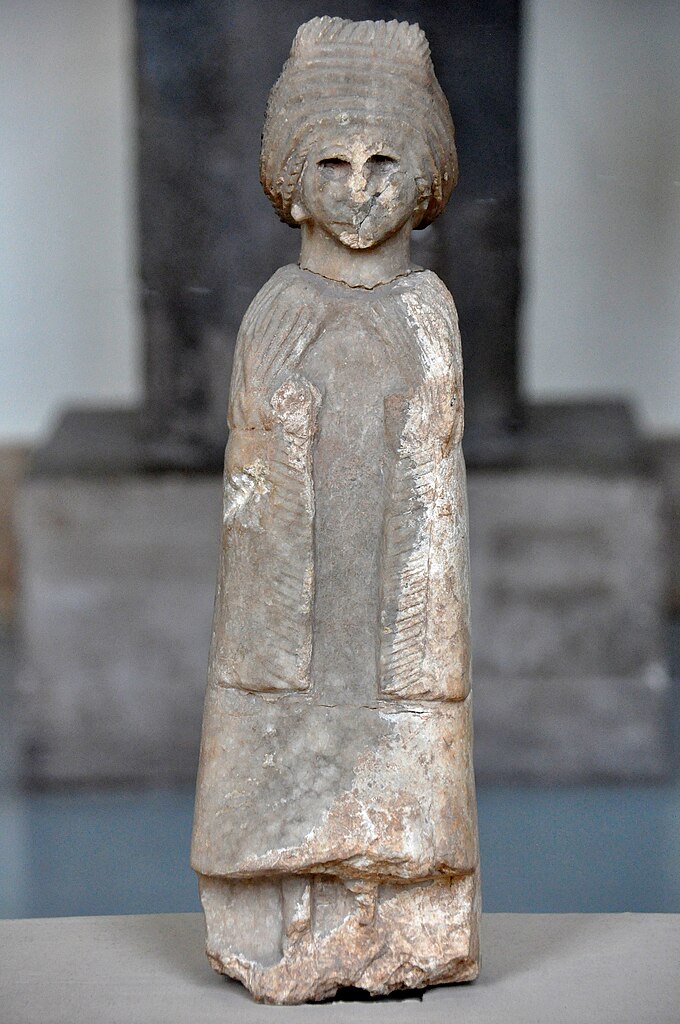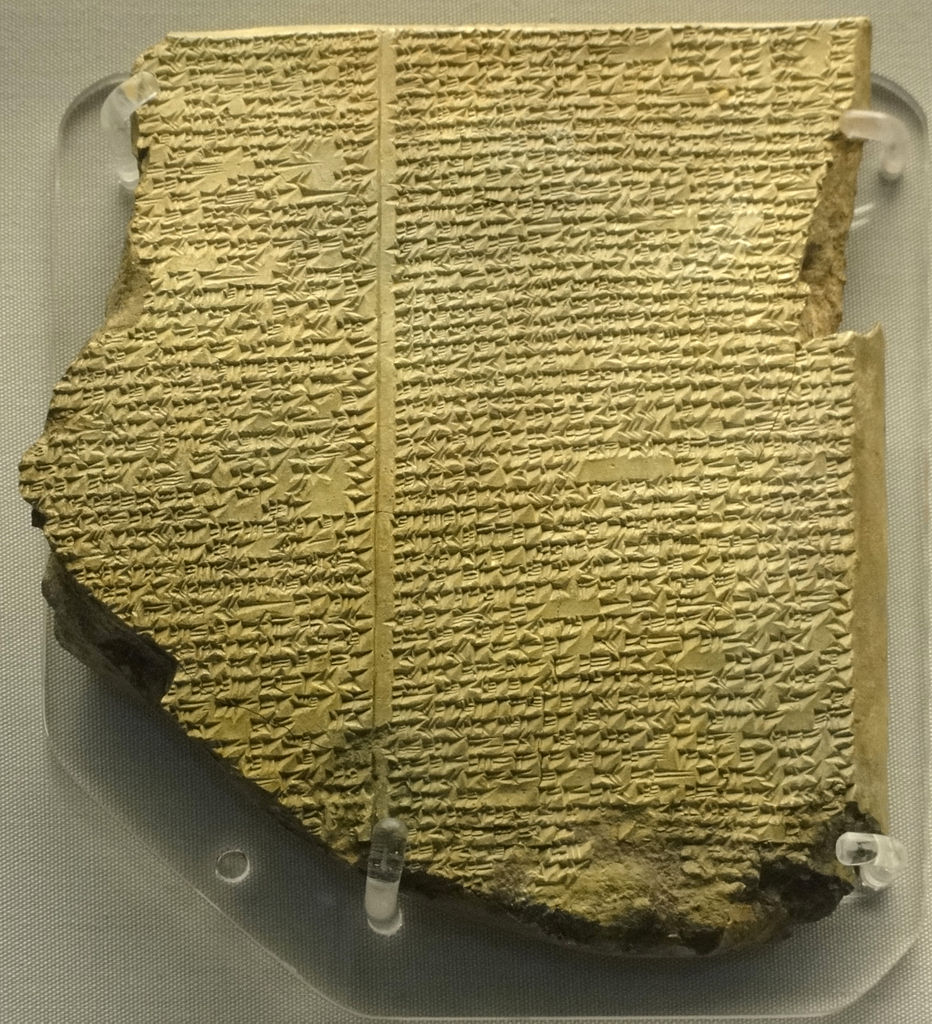Assyria: A history of power, expansion, and cultural legacy
Assyria, a civilization centered in the northern Mesopotamian region along the Tigris River, stands as one of the most formidable and enduring powers of the ancient Near East. From its humble beginnings as a small trading outpost in the city of Ashur during the early Bronze Age, Assyria evolved into a vast empire that at its height dominated much of the Near East, from the Mediterranean Sea to the Iranian Plateau and from Anatolia to Egypt.

The Assyrian sun disk, commonly depicted in Neo-Assyrian royal reliefs, is frequently argued to represent Assur, the ancient Assyrian national deity, but there are scholars who disagree with this identification. Source: Wikimedia Commonsꜛ (license: public domain)
Known for its military prowess, administrative innovations, and cultural achievements, Assyria left an indelible mark on the history of the ancient world. Its ability to integrate diverse peoples and lands into a cohesive empire, supported by a centralized bureaucracy and advanced military strategy, exemplifies the complexity of ancient imperial systems. Yet, Assyria’s rise and fall also reflect the fragility of ancient states, shaped by both external pressures and internal dynamics.
Early beginnings: The city-state of Ashur
The origins of Assyria lie in the small city-state of Ashur, located on the western bank of the Tigris River in what is now northern Iraq. Archaeological evidence suggests that Ashur was settled as early as the third millennium BCE. Initially, it served as a minor center within the orbit of larger Mesopotamian powers, such as Sumer and Akkad. The city’s strategic location along key trade routes connecting Mesopotamia to Anatolia and the Levant enabled its rise as a commercial hub.
 The ancient Assyrian heartland (red) and the later Neo-Assyrian Empire in the 7th century BCE (orange). Source: Wikimedia Commonsꜛ (license: CC BY-SA 4.0)
The ancient Assyrian heartland (red) and the later Neo-Assyrian Empire in the 7th century BCE (orange). Source: Wikimedia Commonsꜛ (license: CC BY-SA 4.0)
During the Old Assyrian Period (ca. 2000–1750 BCE), Assyria’s economy flourished through long-distance trade, particularly in tin and textiles. Merchant colonies, such as those in Kanesh (modern Kültepe, Turkey), established networks that linked Assyria to the wider ancient world. This period also saw the emergence of a distinct Assyrian identity, characterized by a combination of Mesopotamian cultural elements and local traditions.

The ruins of the Old Assyrian trading colony at Kültepe. Source: Wikimedia Commonsꜛ (license: CC BY-SA 3.0)
 Old Assyrian cuneiform tablet from Kültepe recording the repayment of a loan, impressed with four different cylinder seals. Source: Wikimedia Commonsꜛ (license: CC BY-SA 1.0)
Old Assyrian cuneiform tablet from Kültepe recording the repayment of a loan, impressed with four different cylinder seals. Source: Wikimedia Commonsꜛ (license: CC BY-SA 1.0)
The Assyrian kingdom: Middle Assyrian period
The transformation of Assyria from a city-state to a territorial kingdom began in the Middle Assyrian Period (ca. 1350–1000 BCE). Under kings such as Ashur-uballit I and Tiglath-Pileser I, Assyria expanded its influence beyond its immediate surroundings, asserting control over neighboring territories and challenging rival powers, including the Hittites and Babylonians.
 Map of the medio-assyrian kingdom (End of the 13th, beginning of the 11th centuries BCE). Source: Wikimedia Commonsꜛ (license: CC BY-SA 3.0)
Map of the medio-assyrian kingdom (End of the 13th, beginning of the 11th centuries BCE). Source: Wikimedia Commonsꜛ (license: CC BY-SA 3.0)
This period was marked by significant administrative and legal developments. The Middle Assyrian Laws, a set of legal codes, reveal a society structured around strict hierarchies, with clear distinctions between social classes, gender roles, and ethnic groups. Assyria’s governance relied on a centralized bureaucracy, supported by provincial governors who oversaw taxation, military conscription, and resource management.
The Middle Assyrian Period also witnessed the consolidation of Ashur’s religious and political significance. Ashur, the chief deity of the Assyrian pantheon, was closely linked to the state’s ideology. Assyrian kings portrayed themselves as divinely appointed representatives of Ashur, tasked with maintaining cosmic and political order through conquest and governance.
The Neo-Assyrian empire: Imperial expansion and zenith
The Neo-Assyrian Empire (ca. 911–609 BCE) represents the apex of Assyrian power and influence. During this period, Assyria emerged as the first true empire in history, characterized by its unprecedented scale, administrative sophistication, and cultural achievements.
 Map of the Assyrian Empire at 824 BCE (dark green) and 671 BCE (light green). Source: Wikimedia Commonsꜛ (license: public domain)
Map of the Assyrian Empire at 824 BCE (dark green) and 671 BCE (light green). Source: Wikimedia Commonsꜛ (license: public domain)
Under rulers such as Ashurnasirpal II, Tiglath-Pileser III, Sargon II, Sennacherib, Esarhaddon, and Ashurbanipal, Assyria expanded its territories to include much of the Near East. Key conquests included the subjugation of Babylon, the annexation of Israel, and the occupation of Egypt. These campaigns were supported by a highly organized and disciplined military, known for its use of advanced siege technology, iron weaponry, and logistical planning.

Stele of the Neo-Assyrian king Ashurnasirpal II (r. 883–859 BCE). Source: Wikimedia Commonsꜛ (license: CC BY-SA 2.0)
The Assyrian administrative system was a cornerstone of its imperial success. Provinces were governed by officials directly accountable to the king, ensuring centralized control over vast and diverse territories. Infrastructure projects, such as roads, canals, and fortifications, facilitated communication and resource distribution, while a system of annual tribute bolstered the imperial economy.
 Ruins of one of the entrances of the Northwest Palace at Nimrud (Assyrian capital 879–706 BCE), destroyed by the Islamic State in 2015. Source: Wikimedia Commonsꜛ (license: public domain)
Ruins of one of the entrances of the Northwest Palace at Nimrud (Assyrian capital 879–706 BCE), destroyed by the Islamic State in 2015. Source: Wikimedia Commonsꜛ (license: public domain)
Assyrian kings celebrated their achievements through monumental architecture and artistic displays. The capitals of Nimrud, Khorsabad, and Nineveh featured grand palaces adorned with intricate reliefs depicting royal victories, religious rituals, and scenes of daily life. The library of Ashurbanipal, one of the most significant cultural legacies of Assyria, preserved thousands of cuneiform tablets on topics ranging from literature and science to religion and law.
 Neo-Assyrian relief of Assyrians in a procession. Source: Wikimedia Commonsꜛ (license: CC BY-SA 2.0)
Neo-Assyrian relief of Assyrians in a procession. Source: Wikimedia Commonsꜛ (license: CC BY-SA 2.0)
Religion and ideology
Religion played a central role in Assyrian society, intertwining with its political and military ideology. Ashur, as the head of the pantheon, symbolized both divine and state authority. The king was seen as Ashur’s earthly representative, and his military campaigns were often framed as holy wars to expand Ashur’s dominion.

The head of a female statue, dating to the Akkadian period (c. 2334–2154 BCE). Found at Assur. Source: Wikimedia Commonsꜛ (license: CC BY-SA 4.0)
Assyrian religion also incorporated elements from other Mesopotamian traditions, including the worship of gods such as Ishtar, Marduk, and Shamash. Religious festivals, such as the Akitu (New Year) festival, reinforced the connection between the divine and the state, emphasizing the king’s role as a mediator between gods and people.

Statue of a winged bull from Khorsabad. Source: Wikimedia Commonsꜛ (license: CC BY-SA 3.0)


Left: Statue of a praying woman from the Archaic Ishtar Temple at Assur, Iraq. Early Dynastic period, 2400 BCE. Source: Wikimedia Commonsꜛ (license: CC BY-SA 4.0) – Right: Temple altar offered by Tukulti-Ninurta I. Middle Assyrian Period, reign of Tukulti-Ninurta I, 1243-1207 BCE. From Assur (Ashur), Northern Mesopotamia. Source: Wikimedia Commonsꜛ (license: CC BY-SA 4.0)


Left: Furniture ornament, 9th–8th century BCE, ivory/bone relief. Source: Wikimedia Commonsꜛ (license: CC BY-SA 1.0) – Right: The Black Obelisk of Shalmaneser III, 9th century BCE, from Nimrud. Source: Wikimedia Commonsꜛ (license: CC BY-SA 4.0)
Decline and fall of Assyria
Despite its power, the Neo-Assyrian Empire faced significant challenges, including overextension, internal dissent, and external pressures from rival states. The cost of maintaining a vast empire strained its resources, while rebellions and succession crises weakened central authority.
The final blow came in 612 BCE, when a coalition of Babylonians, Medes, and Scythians sacked Nineveh, the Assyrian capital. The destruction of Nineveh marked the end of the Assyrian Empire, though its cultural and political legacy endured in the succeeding Babylonian and Persian empires.
Legacy of Assyria
Assyria’s impact on history extends far beyond its military conquests and administrative innovations. Its contributions to art, literature, and architecture set standards that influenced later civilizations. The preservation of texts in the library of Ashurbanipal provides invaluable insights into Mesopotamian culture, while Assyrian artistic motifs and techniques spread throughout the ancient Near East.

A tablet from the Library of Ashurbanipal, containing a portion of the Epic of Gilgamesh. Source: Wikimedia Commonsꜛ (license: CC BY-SA 3.0)
Moreover, Assyria’s model of imperial governance, with its emphasis on centralization, bureaucracy, and integration of diverse cultures, served as a blueprint for subsequent empires, from the Achaemenids to the Romans. The memory of Assyria, both as a symbol of power and as a cautionary tale of hubris and decline, has continued to resonate throughout history.
References and further reading
- Kuhrt, A., The Ancient Near East, c. 3000–330 BC, 1997, Taylor & Francis, ISBN: 978-0415167635
- Radner, K., & Robson, E., The Oxford Handbook of Cuneiform Culture, 2020, Oxford University Press, ISBN: 978-0198856030
- Grayson, A. K., Assyrian Rulers of the Early First Millennium BC, 1991, University of Toronto Press, ISBN: 978-0802059659
- Reade, J. E., Assyrian Sculpture, 1998, British Museum Press, ISBN: 978-0714121413































comments